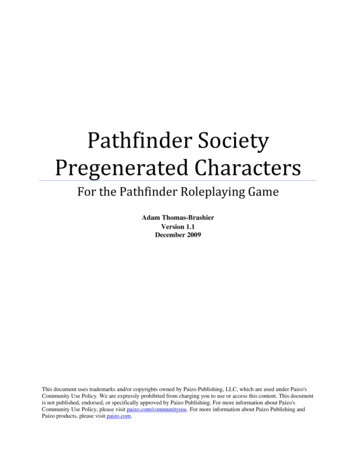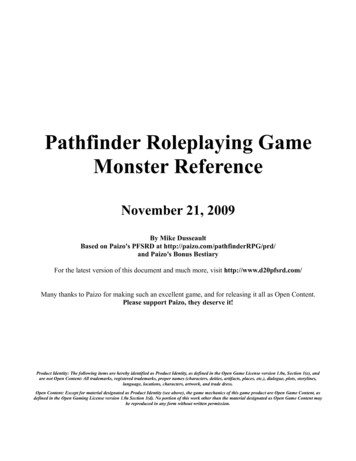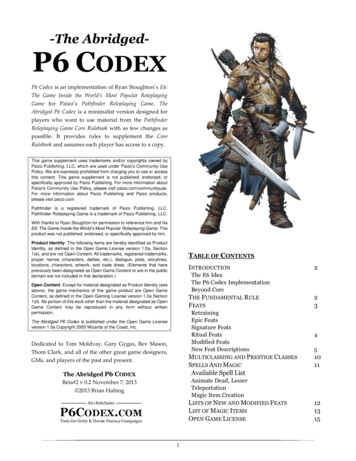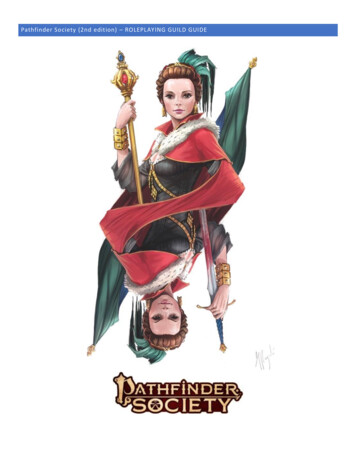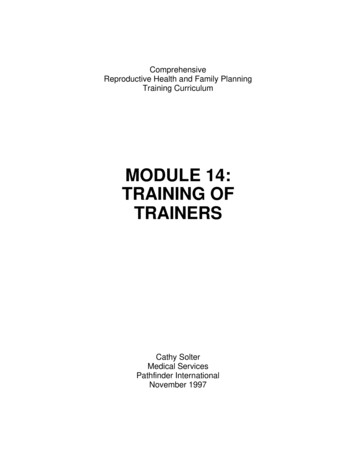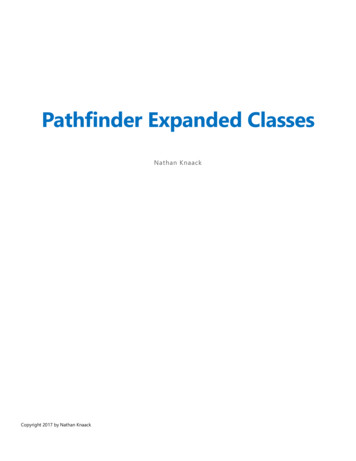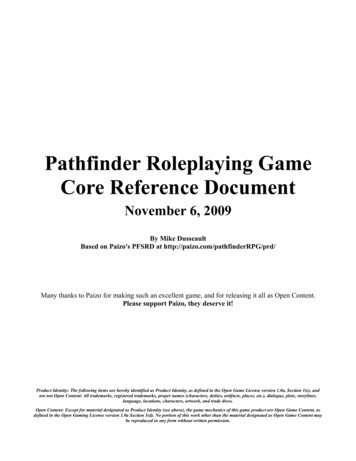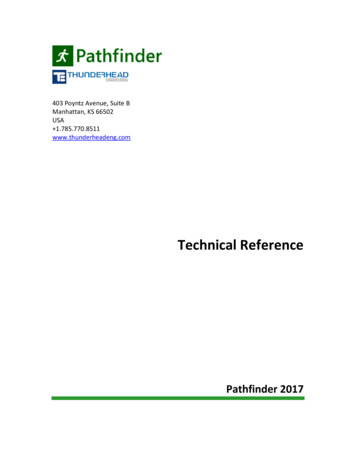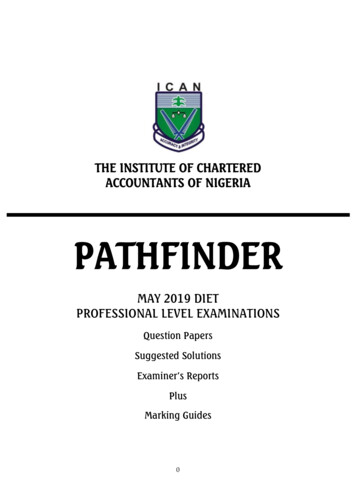
Transcription
THE INSTITUTE OF CHARTEREDACCOUNTANTS OF NIGERIAPATHFINDERMAY 2019 DIETPROFESSIONAL LEVEL EXAMINATIONSQuestion PapersSuggested SolutionsExaminer‟s ReportsPlusMarking Guides0
FOREWARDThis issue of the PATHFINDER is published principally, in response to a growingdemand for an aid to:(i)Candidates preparing to write future examinations of the Institute ofChartered Accountants of Nigeria (ICAN);(ii)Unsuccessful candidates in the identification of those areas in which theylost marks and need to improve their knowledge and presentation;(iii)Lecturers and students interested in acquisition of knowledge in the relevantsubject contained herein; and(iv)The professional; in improving pre-examinations and screening processes,and thus the professional performance of candidates.The answers provided in this publication do not exhaust all possible alternativeapproaches to solving these questions. Efforts had been made to use the methods,which will save much of the scarce examination time. Also, in order to facilitateteaching, questions may be edited so that some principles or their application maybe more clearly demonstrated.It is hoped that the suggested answers will prove to be of tremendous assistance tostudents and those who assist them in their preparations for the Institute‟sExaminations.NOTESAlthough these suggested solutions have been published under theInstitute‟s name, they do not represent the views of the Council of theInstitute. The suggested solutions are entirely the responsibility of theirauthors and the Institute will not enter into any correspondence on them.1
TABLE OF CONTENTSPAGEFOREWARD4CORPORATE REPORTING3 – 34ADVANCED TAXATION35 – 77STRATEGIC FINANCIAL MANAGEMENT78 – 113ADVANCED AUDIT AND ASSURANCE114 – 137CASE STUDY138 - 1642
THE INSTITUTE OF CHARTERED ACCOUNTANTS OF NIGERIAPROFESSIONAL LEVEL EXAMINATION – MAY 2019CORPORATE REPORTINGTime Allowed: 31/4 hours (including 15 minutes reading time)INSTRUCTION:YOU ARE REQUIRED TO ANSWER FIVE OUT OF SEVENQUESTIONS IN THIS PAPERSECTION A:COMPULSORY QUESTION(30 MARKS)QUESTION 1Oyin Plc. a Nigerian company acquired 960 million equity share capital of KemyPlc., a foreign subsidiary based in Brazil, on 1 October, 2015 for 1.08 billionBrazilian real (BRL). The functional and presentation currency of Kemy Plc. is theBRL. Since acquisition, Kemy Plc., has operated autonomously of Oyin group.The statements of financial position of Oyin Plc. and Kemy Plc. as at 30 September,2017 are as follows:Oyin Plc.N‟000N‟000Kemy ,0001,200,000Assets:Non-current assets:Property, plants & equipmentInvestments in Kemy Plc.Current Assets:InventoriesTrade 5,000765,0001,890,000Total Assets3945,0002,145,000
Equity and Liabilities:Equity:Ordinary share capital: N0.50/0.50BRL450,000525,000975,000Revaluation reservesRetained earningsNon-current liabilities:10% loan notes8% redeemable preference 5,000150,000390,000Current liabilities:Trade payablesTaxationBank 1,890,000Total equity and liabilities525,000420,0002,145,000Additional Information:(i)It is the policy of Oyin Plc. group to recognise non-controlling interest atacquisition at the proportionate share of the net assets. The retainedearnings of Kemy Plc., at the date of acquisition were 390 million BRL.(ii)Kemy Plc. sells goods to Oyin Plc. at cost plus a mark-up of 33 1 3 %. At 30September, 2017, Oyin Plc., held N15 million of the goods. The goods werepurchased at an exchange rate of N1 to 5BRL. On 28 September, 2017, OyinPlc. sent Kemy Plc., a payment for N15 million to clear the intra-grouppayables. Kemy received and recorded the cash on 2 October, 2017.(iii)On 1 October, 2016, Kemy Plc. purchased a leasehold building for 375million BRL, taking out a loan note payable after five years to finance thepurchase. The estimated useful life of the building on 1 October, 2016 was25 years with no estimated residual value. The building is to be depreciatedon straight line basis. The building was professionally revalued at 450million BRL on 30 September, 2017 and the directors have included therevalued amount in the statement of financial position.Both companies adopt a policy of revaluation for their properties. There wasno difference between the carrying amount and fair value of the property ofOyin Plc. at 30 September, 2017.4
(iv)Exchange rates are as follows:Date1 October, 201530 September, 201530 September, 2017Average for the year to 30 September, 2016BRL to N16.05.55.05.2Required:Prepare the consolidated statement of financial position of Oyin group at 30September, 2017.(30 Marks)SECTION B:YOU ARE REQUIRED TO ANSWER ANY TWO OUT OF THREEQUESTIONS IN THIS SECTION(40 MARKS)QUESTION 2Below is the draft financial statement of Lanwani Plc. a manufacturer of fastmoving consumer goods.Statement of financial position as atNon-Current AssetsProperty, plant and equipmentIntangible assetsOther non-current assetsCurrent AssetsInventoriesTrade receivablesCash and bankTotal assetsEquities and liabilities:EquitiesShare capital (N1 each)Share premiumRevaluation reserveRetained 3,77045,32099,692222,7803,96464,95096,343165,257
Non-Current liabilities:Loans and borrowingsEmployee benefitsCurrent liabilities:Bank overdraftCurrent tax liabilitiesTrade payablesTotal equity and liabilitiesStatement of profit or lossRevenueCost of salesGross profitDistribution expensesAdministrative expensesFinance costProfit before taxIncome tax expenseProfit for the 257)27,759The following additional information are relevant:(i)The Company changed its accounting policy from the cost model to therevaluation model for its property. The amount in revaluation reserverepresents the revaluation surplus recognised in 2017. No adjustmentwas made in respect of 2016.(ii)Development cost of N45 billion was capitalised during 2017. The relatedasset is not expected to generate any economic benefit until 2020.Required:a.Assess the accounting treatment of the change in accounting policy andstate the impact on the return on capital employed (ROCE).(3 Marks)b.Analyse the profitability, liquidity and efficiency of Lanwani Plc. (15 Marks)c.Briefly discuss TWO limitations of the analysis done in (b) above.6(2 Marks)
QUESTION 3Ariba Bank Plc. (the Bank) is a Tier 1 Bank in Nigeria with branch network acrossall the six geo-political zones of the country. Its credit portfolio is spread amongmany industries with a special focus on the oil and gas industry and real estate.One of its major customers with a very good credit standing is Dunga PropertyDevelopment Company (DPDC).The management of DPDC recently approved a plan to build four shopping malls inmajor cities across the country. A special purpose entity was registered as a limitedliability company, Dunga Malls Limited (DML), dedicated to the development andmanagement of the malls. The project will be solely financed by a loan to beobtained from Ariba Bank. There will be no equity contribution from DPDC otherthan the minimum required by law to establish a company.Ariba Bank has approved a loan of N80 billion at a fixed interest rate of 15% perannum payable annually in arrears. The loan has a maturity of 10 years with amoratorium of 3 years. There was no transaction cost and therefore the contractualrate is the same as the effective rate. The loan was granted directly to DML on 1January, 2018.The Financial Controller of Ariba Bank Plc. is concerned about the accountingtreatment of the loan as IFRS 9 Financial Instrument was adopted by the bankduring the year. He noted that majority of the bank loans are classified atamortised cost in the statement of financial position but the loans must pass certaintests before such classification.The Chief Risk Officer noted in his memo that the arrangement is substantially thesame as the other borrowing arrangements of the bank except that a borrowingentity would normally have equity or other assets that could be called upon by thebank in a case of default other than the asset being financed.Required:a.Discuss how financial assets are classified in accordance with therequirements of IFRS 9.(8 Marks)b.Advise the Bank on how the loan granted to DML should be classified in thestatement of financial position.(6 Marks)c.Discuss, with supporting calculations, how the loan will be accounted for inthe financial statement of the bank for the year ended 31 December, 2018(6 Marks)(Total 20 Marks)7
QUESTION 4The Central Bank of Kangora (CBK) operates a post-employment benefit planwhereby employees are entitled to an amount upon completion of employment.Each employee is paid an amount equal to 150% of the annual pay at the time ofretirement multiplied by the number of years in service. The plan is not funded.CBK uses a professional actuary to determine its liability under the plan at the endof every reporting period. The report of the actuary shows that the plan obligationwas N620 million and N906 million as at 1 January, 2018 and 31 December, 2018respectively. The current and past service cost for the year was N108 million. Thediscount rates were 8% and 12% as at 1 January, 2018 and 31 December, 2018respectively.CBK paid a total benefit of N48 million during the year.The financial controller is struggling to complete the reconciliation and accountingentries for the plan. He is particularly confused about the concept of remeasurement and its accounting treatment.Required:a.Differentiate between a defined contribution plan and a defined benefit planand advise CBK on how its post-employment plan should be classified.(5 Marks)b.Complete the reconciliation and show the journal entries required to recordthe transactions for the year ended 31 December, 2018.(10 Marks)c.Discuss the components of re-measurement gain or loss and state theaccounting treatment of a re-measurement gain or loss arising on a definedbenefit plan.(5 Marks)(Total 20 Marks)SECTION C:YOU ARE REQUIRED TO ANSWER ANY TWO OUT OF THREEQUESTIONS IN THIS SECTION(30 MARKS)QUESTION 5a.LPG Plc. is a publicly traded entity on the Nigerian Stock Exchange involvedin the production of and trading in natural gas in Nigeria. LPG Plc. jointlyowns a gas storage facility with another entity, Tan Oil Nigeria Limited. Bothparties extract gas from onshore gas fields in the Niger Delta, which theyown and operate independently from each other. LPG owns 55% of the gasstorage facility and Tan Oil Nigeria owns 45%. Services and costs are sharedbetween them according to their percentage holding, however, decisions8
regarding the storage facility require unanimous agreement of the parties.The gas storage facility is pressurised so that the gas is pushed out whenextracted. When the gas pressure is reduced to a certain level, the remaininggas is irrecoverable and remains in the gas storage facility until it isdecommissioned. The Nigeria law requires the decommissioning of thestorage facility at the end of its useful life. LPG Plc. wishes to know how totreat the agreement with Tan Oil Nigeria Limited including any obligation orpossible obligation arising on the gas storage facility.NB Ignore accounting for the irrecoverable gas.b.LPG purchased a major gas plant on 1 January, 2018 and the Directorsestimated that a major overhaul is required every two years. The costs of theoverhaul are approximately N25 million which comprises N15 million forparts and equipment and N10 million for labour. The Directors proposed toaccrue the cost of the overhaul over the two years of operations up to thatdate and create a provision for the expenditure.Required:Discuss, with reference to International Financial Reporting Standards (IFRS), howLPG Plc should account for the agreement in (a) above (11 marks) and thetransactions in (b) for its year ended 31 August, 2018.(4 marks)(Total 15 Marks)QUESTION 6Dangogo Plc. has adopted IFRS in the preparation and presentation of its financialstatements in line with Financial Reporting Council of Nigeria requirements. Duringdeliberations on their financial statements for the year ended 31 March, 2019 thedirectors of Dangogo Plc. found the distinction between profit or loss and othercomprehensive income confusing. This is the case with many other preparers orusers of financial statements in Nigeria who seem to be unclear about therelationship between profit or loss and other comprehensive income (OCI). Theyblame the conceptual framework for Financial Reporting and IAS 1 regarding theconfusing nature of re-classification. The emergence of integrated reporting holdspromises for better reporting, but preparers are equally uncertain about whetherthe International Integrated Reporting Councils (IIRC) or Integrated Reporting (IR)Framework constitutes suitable criteria for report preparation.Required:a.Discuss the nature of a re-classification adjustment and the arguments forand against allowing re-classification of items to profit or loss.(6 Marks)9
bi.Discuss the objectives of integrated reporting and key components(content elements) of integrated report.(6 Marks)ii.Comment on any concerns which could limit the Framework‟s suitability forassessing the performance and prospects of an entity.(3 Marks)(Total 15 Marks)QUESTION 7a.Agbinye Farms operates many plantations across Nigeria. The Companyrecently acquired a freehold land in Benue for a total of N12 million. Thetrees were planted with the company incurring an operating cost of N4million up to 31 March, 2018 which is the co
PATHFINDER MAY 2019 DIET PROFESSIONAL LEVEL EXAMINATIONS Question Papers Suggested Solutions Examiner‟s Reports Plus Marking Guides . 1 FOREWARD This issue of the PATHFINDER is published principally, in response to a growing demand for an aid to: (i) Candidates preparing to write future examinations of the Institute of Chartered Accountants of Nigeria (ICAN); (ii) Unsuccessful

